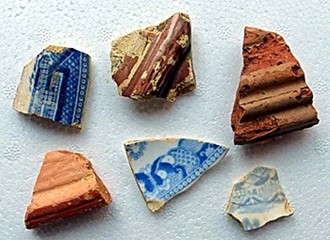
The origins of wayside rubbish
in the countryside
by Rex Needle
|
Many people are baffled at finding various artefacts from past times during their walks around the countryside and as much of this appears to be quite old rather than recent rubbish discarded by litter louts, their origins are a matter of curiosity. The arable fields adjoining the Car Dyke which runs through the Bourne area has produced a great deal of material, mainly broken earthenware and even fragments of willow pattern pottery, while on the outskirts of Dyke village he found several glass bottles, one of which was impressed Yorkshire Relish 1885. "Why should stuff like this turn up in the fields so far from the town?" asks inveterate walker Geoff Bell, of Princes Court, Bourne. "Perhaps they are the remains of an old rubbish dump from years ago although it is a long way from any road which would allow access." We should remember that the fields today are farmed by machines but in past times it was people, dozens of them at harvest time when entire families would turn out to help with gathering in the corn, and as their place of work was often several miles away from their homes they took with them food and drink and the rubbish this produced would be thrown away, wrappings, broken china and empty bottles. The same debris would be left by picnic parties, a favourite diversion in Victorian times when couples and families would chose an attractive spot at the cornfield’s edge or beside a waterway for their outdoor repast. The other contributory factor is that the establishment of organised rubbish dumps and domestic refuse collections is comparatively recent because they were unknown in Bourne prior to 1900. Before that, household waste was discarded at any convenient location, watercourses being a favourite spot, and there were also many unofficial tips that became established through common usage rather than official designation, although the amount of refuse in those days was a mere fraction of what we throw away today. Once of the worst places for dumping was in the moat section of the Bourne Eau where it runs behind West Street and we have records that it became a magnet for rubbish, much of it thrown out by the inhabitants of nearby dwellings who merely had to walk to the bottom of their yard or garden to get rid of their dirty water and kitchen waste. Regular weekly household rubbish collections were established by law under Disraeli's Public Health Act in 1875 which imposed new standards of sanitation on local authorities in an attempt to stamp out cholera and other diseases spread by contaminated waste which claimed large numbers of lives. Since then, the right of British householders to have their refuse collected at least once a week has been recognised as essential to the nation's health and quality of life. It took some years for the scheme to be implemented throughout the country but by the turn of the century, weekly collections were being made in Bourne although only on a sporadic basis. The disposal of household waste became the responsibility of Bourne Urban District Council when it was formed in April 1899 but a regularised collection of domestic rubbish did not begin until 1911. This consisted of a horse and cart with a bell attached to alert home owners that it was in the vicinity and the dustman, as he was known, was paid one shilling an hour for his services. The various parts of the town were covered in four days of each week and the rubbish collected was taken to the brick pits off West Road for disposal. By 1930, weekly door-to-door collections as we know them today were fully operational with each household using a galvanised bin that was left within easy reach of the dustmen when they made their call. The rubbish was then carted to a central dump, now known as landfill sites, and buried a procedure that has continued ever since, although with slight variations, from the use of plastic bags and boxes to the system we have today with wheelie bins collected on a regular basis and much of the rubbish separated for recycling. The fields and hedgerows were therefore the most convenient place to get rid of rubbish in past times and although much of it has since been cleared up with the passing of the years, odd items still surface, especially along the route of rivers, dykes, farm tracks and roads, as a pertinent reminder that no matter what criticism we may have of the refuse collection system we have today, without it the countryside might once again become a vast rubbish dump. WRITTEN OCTOBER 2014
Go to: Main Index Villages Index |